Thirsty Thursdays January 2019: A Thirsty New Year
By Allison Senecal — Superhero comic art has evolved at a really impressive rate in recent years...so much so that sometimes it can be a lot to handle. First there’s excitement, obviously, but then that excitement turns into something else...which is why each month we’re running our Thirsty Thursday rankings, a new and different way to look at our favorite comic art. Welcome to a sporadic examination of (as the kids say) the month’s thirstiest comics.
Enjoy!
Artist: Mahmud Asrar
Colorist: Matt Wilson
Conan the Barbarian #1 - I came into 2019 praying that the new Conan line from Marvel would deliver the goods every month, and so far it’s batting a thousand. It’s sexyyyyyyyyyyy. Here’s hoping Asrar and Wilson get to give us their take on Bêlit before they’re done. 💦💦💦💦💦 out of 5
Conan, what is best in life?
Artist: German García
Colorist: Addison Duke
Barbarella/Dejah Thoris #1 - It’s been weeks and I still can’t shut up about how gorgeous and charming this damn opening issue was. García and Duke’s Dejah Thoris is the best iteration of the character I’ve ever seen, and they aced Barb’s whole vibe as well. The ideal blend of cute and sexy, with pitch perfect banter from Williams that I assume will only get better in future issues. 💦💦💦💦💦 out of 5
I hope someone brought water to this team-up because a thirst warning is in full effect!
Artists: Carlos Magno and Butch Guice
Colorist: Alex Guimarães
Invaders #1 - NAMOR! So much Namor! And Steve in a military jacket! NAMOR IN A SUIT! Bet y’all didn’t think Invaders could be a sleeper thirst series of 2019, but this art team is here to prove you wrong. 💦💦💦💦 out of 5
This guy on the left?…SAME.
Artist: Iban Coello
Colorist: Andres Mossa
Man Without Fear #3 - Tough to pick one issue of this series to highlight, and the whole thing was a Sad Matt™ thirst trap, but Coello and Mossa served up the saddest, sweatiest Matt so #3 it is. 💦💦💦💦💦 out of 5
Oh my dear dear Sad Matt™…so sad, so sweaty.
Artist: Juann Cabal
Colorist: Nathan Woodard
Friendly Neighborhood Spider-Man #2 - I know this series is about SPIDER-MAN, but Johnny Storm is babysitting in this issue! I don’t even like kids, but every time Johnny is adorable with them I feel that cynical void inside me whisper “oh %$#&”. 💦💦💦💦 out of 5
I think we all need a lot of things, Johnny.
Artist: Sana Takeda
Monstress #19 - A new crossbow wife???! I keep thinking Sana Takeda is done giving me MORE women with the best designs to swoon over but...Yafaela! 💦💦💦💦💦 out of 5
Is this a type? Can this be a type? I think this is my type…
Artist: Ramon Rosanas
Colorist: Tríona Farrell
Age of X-Man Alpha #1 - Rosanas and Farrell absolutely killed it on this. The character designs (largely courtesy of Mike Hawthorne) are all super swoony and it took me about 40 minutes to read because I kept lingering on every page. I’m sure you’ll be hearing more about Nightcrawler, the X-Tremists squad, and Prisoner X here at some point (okay, many points). 💦💦💦💦💦 out of 5
Clearly, this is the thirstiest timeline.
Artist: Adam Kubert
Colorist: Frank Martin
Captain America #7 - *drags hand down face* Steven Grant Rogers. I just want to thank everyone from the bottom of my heart for the cute sweater. That is all. 💦💦💦💦💦 out of 5
The right of people to choose…how hard they totally flip for freaking CAP IN A SWEATER.
Artist: Caspar Wijngaard
Colorist: Mary Safro
Peter Cannon: Thunderbolt #1 - I admit — and maybe this hurts my journalistic integrity in regards to this column about thirsty comics art — this is the first comic in a long time I purchased purely as a thirst read. Gillen knows it!! He compared it to Dream Daddies in a solicit, for God’s sake. I don’t know #$%& about the Thunderbolt property but 1. this was a fantastic first issue, and 2. Peter and Tabu (and Nucleon???!!) are hot. 💦💦💦💦💦 out of 5
I’ll have a glass of that too because this book is seriously thirsty.
Sorry ahead of time for the panel by panel breakdowns of Daredevil #1-2 next month. You may think I’m kidding, but am I?
Check out The Thirstiest Comics of December.
Allison buys books professionally and comics unprofessionally. You can find her chaotic neutral Twitter feed at @maliciousglee.











